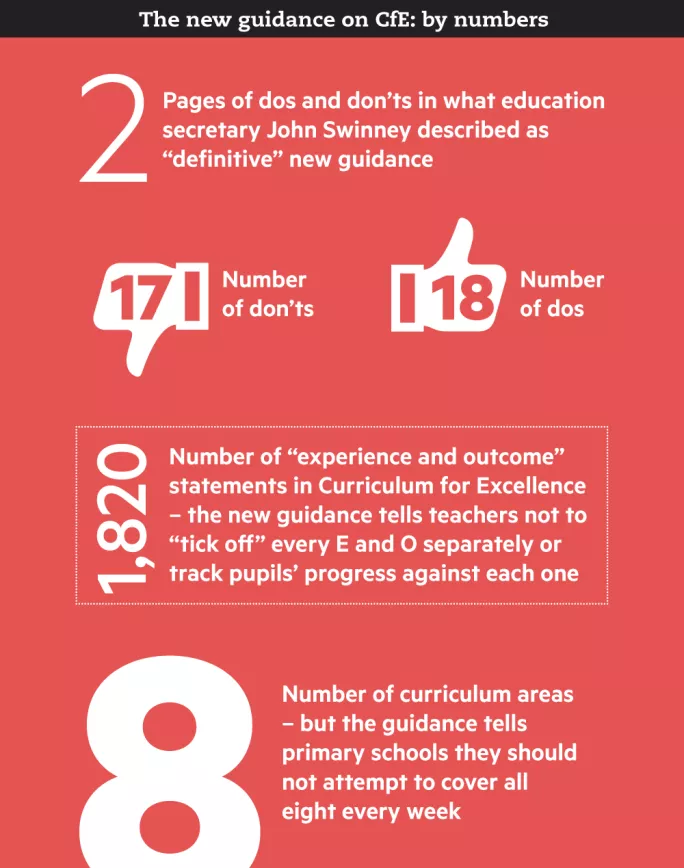Inspectors ‘will help to cut teachers’ red tape’
School inspectors will not hinder the government’s drive to free teachers from unnecessary bureaucracy by asking for reams of evidence from headteachers, Scotland’s chief inspector has indicated.
Education secretary John Swinney this week advised teachers to “focus on young people” and not to “fill a lever arch file with endless amounts of detail”.
He issued the advice as he launched new guidance designed to give “absolute clarity” to teachers about “what is and what is not required” under the Curriculum for Excellence.
In response, Bill Maxwell, Scotland’s chief inspector of education, told TESS: “I can absolutely give you reassurances that there won’t be a disconnect [between the new guidance and inspection]. Nowadays we have, on a number of occasions, seen inspection reports where effectively the main point of action has been about reducing bureaucracy and improving, streamlining processes.”
School inspectors were already undergoing training so that the new guidance would be embedded, he said.
Mr Maxwell added that it was now more than ever down to schools to make judgements for themselves about the amount of written evidence they should collect about pupils’ learning.
“Fundamentally, that comes down now to the professionalism of teachers and their leaders within schools…I don’t think it would be helpful for us to micro-prescribe that from the top,” he said.
Mr Maxwell spoke as the government also published benchmarks for maths and English for the first time, so schools can be clear about what learners hitting the different CfE levels should be able to do.
The guidance comes amid fears that teachers are becoming bogged down in excessive paperwork and red tape in the name of CfE. However, one expert in curriculum theory has hit out at Mr Swinney’s attempt to bring coherence to CfE, saying that the new guidance had added “new complexity”.

‘Contradictory’ guidance
Mark Priestley, a professor of education at the University of Stirling today called for the existing - “often contradictory” - CfE documentation to be replaced by a single set of detailed guidance (see box, “A new layer of complexity”, below).
Primary headteachers’ organisation AHDS has, meanwhile, questioned whether future inspections will actually reflect the new guidance. Only last week, Education Scotland issued a briefing to schools on the evidence that would be required before and during an inspection, said AHDS president Robert Hair.
Included in the list were samples of children’s work in literacy and numeracy, across learning, from each class. Inspectors also required information about children’s progress and performance over time and any available benchmarking data and information about how children’s achievements (including attainment) were tracked.
‘The government is talking as if teachers are in control of this agenda’
Mr Hair, headteacher of Kinloss Primary in Moray, said: “It’s early days. We need to wait and see what the next tranche of school visits by HMI brings and what their expectation in relation to evidence is and whether that is in line with what this advice is saying.”
Teachers commenting on Twitter said that senior managers would ignore the new anti-bureaucracy guidance because of “the need to be inspection compliant” (see box, “How the Twitterati reacted”, below).
Scotland’s largest teaching union, the EIS, has criticised “top-down management” from Education Scotland, councils and the Scottish government itself. EIS general secretary Larry Flanagan said: “The government is talking as if teachers are in control of this agenda. Saying that teachers are now empowered to challenge this is a long way from making sure local authorities and senior management in schools are in line with the message.”
However, Mr Flanagan said that the documents would bring some benefits. The new benchmarks would be particularly useful for schools and teachers, he argued.
Meanwhile, Ashley Abercrombie, a teacher at St Roch’s Primary in Glasgow, where the new materials were launched, said that the guidance would give teachers the confidence to have two or three pieces of strong evidence, as opposed to 10 folders of evidence. The new guidance was “succinct”, which meant it would be referred to by teachers frequently, she concluded.
You need a Tes subscription to read this article
Subscribe now to read this article and get other subscriber-only content:
- Unlimited access to all Tes magazine content
- Exclusive subscriber-only stories
- Award-winning email newsletters
Already a subscriber? Log in
You need a subscription to read this article
Subscribe now to read this article and get other subscriber-only content, including:
- Unlimited access to all Tes magazine content
- Exclusive subscriber-only stories
- Award-winning email newsletters
topics in this article



